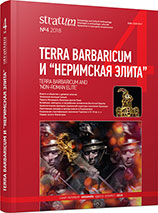Тамгообразные знаки из Ольвии (к проблеме сарматского присутствия)
Tamga-shaped Signs from Olbia (to the problem of Sarmatian presence)
Author(s): Roman A. KozlenkoSubject(s): History, Archaeology, Cultural history, Social history, Ancient World
Published by: Издательский дом Stratum, Университет «Высшая антропологическая школа»
Keywords: Olbia; Roman fort; 1st—2nd cent. AD; tamga-signs; Sarmatians
Summary/Abstract: The article analyzes a number of tamga-signs discovered during the archaeological research of Olbia (city and necropolis) and the Roman military camp Kamenka V, located on the north-western border of the Olbian state. On the basis of these finds, as well as a number of elements and archaeological complexes from Olbia, an assumption is advanced and maintained about the immediate Sarmatian presence within the city in the third quarter of the 1st and beginning of the 2nd centuries AD. A brief description of the unique archaeological complex of the third quarter of the 1st century is also given, found in a structure in the upper city of Olbia: with elements of the Sarmatian combat kit, a rich assortment of amphora, red-lacquered, glass and stucco ware belonging to an elite warrior, probably an archer rider, who was on the territory of Olbia during the events associated with close political relations between Olbia, the Sarmatians and the Roman Empire. Tamga-signs on the limestone slab, astragals, stucco, amphora, red-lacquer and figurine ware probably appear in Olbia at the same time. In addition, tamgas on stone and amphora walls from the excavations of the Roman fort Kamenka V can testify to the presence of Sarmatian warriors within this fortification. Some of the detected tamgas are found for the first time in the area, and, possibly, in the whole of the Northern Black Sea region.
Journal: Stratum plus. Археология и культурная антропология
- Issue Year: 2018
- Issue No: 4
- Page Range: 239-254
- Page Count: 16
- Language: Russian
- Content File-PDF

